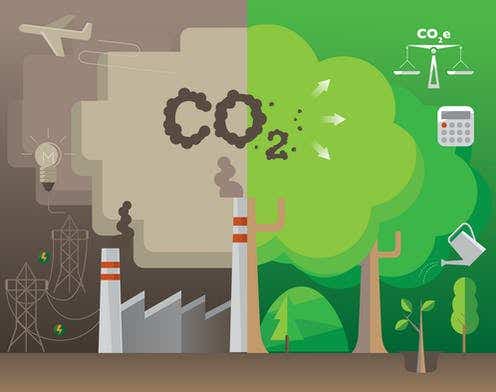The Brighter 5: Five important new technology advancements towards carbon neutrality
Today The Brighter 5 brings you a list of the five most disruptive and promising new technology advancements towards carbon neutrality.

[Feb. 27, 2021: Joseph Shavit]
5. Nature-inspired photocatalysis
Carbon dioxide (CO2) is one of the major greenhouse gases causing global warming. If carbon dioxide could be converted into energy, it would be killing two birds with one stone in addressing the environmental issues. A joint research team led by City University of Hong Kong (CityU) has developed a new photocatalyst which can produce methane fuel (CH4) selectively and effectively from carbon dioxide using sunlight.
"Furthermore, this new catalyst is made from copper-based materials, which is abundant and hence affordable," said Dr Ng. The team has spent more than two years to develop this effective strategy. Their next step will be to further increase the methane production rate and explore ways to scale up both the synthesis of the catalyst and the reactor systems.
Methane has several important uses. It is the main component in natural gas which in turn is used to heating homes, fueling cars, transit buses and powering / heating buildings. Another similar technology being developed by a team at Oxford University proposes to convert CO2 into jet fuel.
4. Direct Air Capture Machines
Remember (in the film Aliens) the terra-forming factories used to convert a planet's toxic to humans atmosphere into one suitable for our habiltation? Direct Air Capture (DAC) machines scrub the atmosphere of CO2 to the same end. Early versions of these facilities already exist: One firm called Carbon Engineering has been developing the technology for over a decade. DAC facilities use giant fans to suck in air, which then passes over special plastic surfaces, where it reacts with a chemical solution that binds to the CO2. The air leaves the facility minus the carbon.
But what might the wide-scale deployment of DAC look like? In a recent paper in the journal Nature Communications, a team of researchers crunched the numbers, arguing that it’s feasible for humanity to embark on a wartime-style crash deployment of a global network of machines that sequester carbon.
The researchers found that with an annual investment of between 1 and 2 percent of the global gross domestic product, humanity could scale up a DAC network to remove around 2.3 gigatons of CO2 annually by the year 2050. (For perspective, total global emissions are currently around 40 gigatons a year.) That’s about 400 times the amount of CO2 humanity currently sequesters.
3. Convert trash to Graphene
Recent technology developed at Rice University is taking the idea that one man's trash is another man's treasure to its extreme. Banana peels, coffee grounds, single-use plastic containers, coal — all of these and more are being turned into one of the most valuable materials around: graphene. Chemist James Tour and his team have developed a rapid process that can transform bulk-quantities of junk into flakes of graphene.
"This is a big deal," said Tour in a Rice University press release. "The world throws out 30 percent to 40 percent of all food, because it goes bad, and plastic waste is of worldwide concern. We've already proven that any solid carbon-based matter, including mixed plastic waste and rubber tires, can be turned into graphene."
Graphene's value is mainly due to its incredible strength and the wide variety of industrial applications it possesses. It is extremely useful in scientific experiments due to its high reactivity and strength, it can also be added to all sorts of other materials to improve their strength or to make them more lightweight, such as concrete or metals. It is the most conductive material, making it invaluable for use as a heat sink in, for instance, LEDs or smartphones. It could also be used in battery technology, in paints, in sensors, and many more.
2. Improving Coal Burning Efficiency
A team of Russian scientists has suggested a new approach to modifying the combustion behavior of coal. The addition of copper salts reduces the content of unburnt carbon in ash residue by 3.1 times and CO content in the gaseous combustion products by 40%, the scientists found.
Coal is the predominant energy resource used for power generation. According to reports, coal supplied over one-third of global electricity generation in 2020. Experts believe that despite the generally accepted energy policy aimed at reducing the share of coal usage and switching to renewable energy sources, coal, as the main type of fuel in the world, will most likely still occupy a leading position in power generation in the coming years. Taking this into account, development of technologies aiming at more effective and environmentally friendly coal thermal conversion is a priority task for the coal-fired power generation industry.
The researchers believe that the use of salt-based additives for increasing the efficiency of coal-burning could help improve fuel efficiency in energy production, minimize energy use for preheating power generating equipment and reduce carbon emissions from coal-fired power plants.
1. Genetically engineered trees
While there is controversy over genetic engineering, some scientists say it could also help fight climate change by creating trees that grow bigger, faster, resist disease and can even turn carbon into a stable white powder that falls to the ground — in other words, trees that would be better at pulling carbon from the atmosphere.
Using trees to fight climate change is based on the idea that planting more trees increases photosynthesis, the mechanism by which plants turn carbon dioxide into breathable oxygen. Carbon is pulled out of the air and is converted into biomass — leaves or needles, trunks and roots — or stored in the soil, adding to natural reservoirs of captured carbon called carbon sinks. But the carbon that trees take up doesn't stay there for good. They can send it back into the atmosphere through respiration, or when disturbances like forest fires and insect infestations cause trees to release carbon stored in their tissues when they burn or decay.
Scientists believe genetically modified trees could allow the tree to grow twice as fast, absorb twice as much carbon in half the time, and sequester even more carbon from the atmosphere to slow down the climate crisis.
Like these kind of stories? Get The Brighter Side of News' newsletter.
Other technologies to follow:
1. Building cities with wood rather than concrete: Building generates roughly one-third of global greenhouse gas emissions – 10-times more than air traffic. Using wood instead of conventional materials could slash emissions by effectively storing millions of tonnes of carbon, according to the researchers at Aalto University and the Finnish Environment Institute.
2. Bendable concrete and other CO2-infused cement mixes could dramatically cut global emissions: The production of cement, the binding element in concrete, accounted for 7% of total global carbon dioxide emissions in 2018 with an estimated 26 billion tons produced annually worldwide.
3. The robot that could help make the shipping industry greener: When a ship sails through the sea, barnacles, mussels, algae, and other organisms stick to the hull of the vessel. This process is called biofouling -- and it's a big problem for the shipping industry. Biofouling increases the drag of ships, so more energy is needed to power them, increasing fuel costs and multiplying their carbon emissions.
4. Startup Turns Polluted Air Into Climate-Friendly Tiles: They capture and convert carbon soot from cars and factories into sustainable products, and use a similar process to upcycle purified carbon into a powder pigment. They then mix this carbon pigment with cement and marble waste from quarries to produce handcrafted, monochromatic tiles.
5. Start-up Creates Carbon Negative Displosable Plastic Straws and Utensils: The startup uses ocean bacteria to create a new material that is made of methane, a potent greenhouse gas, and that can replace many single-use plastics and leathers. The new biomaterial, which can be shaped into anything from straws to office chairs to frames for glasses, is durable, completely biodegradable in the ocean and carbon-negative.
Tags: #Green_Good_News, #Trees, #CO2, #Carbon_Neutrality, #The_Brighter_5, #The_Brighter_Side_of_News
Joseph Shavit
Head Science News Writer | Communicating Innovation & Discovery
Based in Los Angeles, Joseph Shavit is an accomplished science journalist, head science news writer and co-founder at The Brighter Side of News, where he translates cutting-edge discoveries into compelling stories for a broad audience. With a strong background spanning science, business, product management, media leadership, and entrepreneurship, Joseph brings a unique perspective to science communication. His expertise allows him to uncover the intersection of technological advancements and market potential, shedding light on how groundbreaking research evolves into transformative products and industries.



